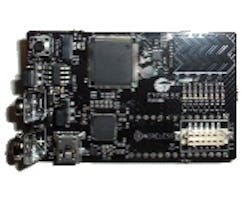PSoC FirstTouch development board
PSoC FirstTouch accelerometer demo
The kit handles a range of modules
PSoC Development Kit modules
PSoC Development Kit USB-based debugger
If you are looking for a hands-on look at Cypress Semiconductor's PSoC dev kits then you have arrived at the right place. In this article I take a look at the $49 PSoC FirstTouch Starter Kits for the PSoC-3 (CY8CKIT-003) and the PSoC 5 (CY8CKIT-014) as well as the $249 PSoC Development Kit (CY8CKIT-001). These kits come with a copy of Cypress Semiconductor's PSoC Creator and you can download a copy of PSoC Designer from Cypress Semiconductor's website. I also have a hands-on review of this software as well.
The PSoC 1 kit is USB-based and has been available for a number of years. I suspect that a First Touch start kit for the PSoC 1 will not be in the works because this kit is available and because the 8051-based PSoC 3 is becoming more popular.
PSoC FirstTouch Starter Kits
The PSoC FirstTouch Starter Kits are available for the PSoC-3 (CY8CKIT-003) and the PSoC 5 (CY8CKIT-014). They are essentially identical with a respective processor chip on-board. Each kit comes with the processor board, a 9V battery, USB cable and a CD with documentation and software. The board is programmed and debugged using the USB cable. There is actually a USB micro on-board that handles this interface. Power is provided by the USB connection when used. The battery provides standalone operation.
The boards have eight LEDs, an accelerometer, thermistor and a CapSense touch-sensing interface. A capacitive proximity sensing system can be implemented as well. A wire antenna is provided for this support.
Overall this is a nice little module. There is a 12-pin wireless header that works with Cypress supplied wireless modules. The board also brings out 28 general purpose I/O pins that match a standard DIP header. I was able to plug this into a breadboard for a small robot using the I/O pins to control it. The wireless module provides a mechanism for remote control and Cypress provides a range
Out of the box, the module is programmed with an application that takes advantage of the eight LEDs and the accelerometer. Shake the powered module back and forth and it displays PSoC Rocks using the LEDs.
PSoC Development Kit
I didn't try flipping the PSoC Development Kit as the board is a bit larger. It uses plug-in modules allowing you to swap out processors easily. This makes more sense since the kit comes with PSoC 1, PSoC 3 and PSoC 5 modules.
The host board includes a breakout board with headers nearby that expose the microcontroller's I/O pins. There are four headers (40- and 60-pin) that provide access to all the I/O pins for off-board use as well. The wireless module header is also available. It matches the one on the FirstTouch boards. There are two round CapSense touch areas along with a larger rectangular area. The LCD module uses a parallel interface.
The kit comes with a 12V power adapter and USB cable for debugging. There is also a connection for a 9V battery. This mix of connections allowed me to test sytems using a variety of power sources.
The development kit provides a more substantial development platform than the FirstTouch kits. Out-of-the-box there is limited system test that essentially shows the LCD and microcontroller is working. Of course, the kinds of applications you can develop and test are more ambitious than what can be done with the FirstTouch platform.
I like the module approach because the processor modules can potentially be used on prototypes as well. They are still a bit large but they are more flexible than building a module from scratch.
The development kit uses a USB-based programming dongle instead of having the programmer on each processor module or the host board. The dongle plugs into the host board but there is also a header on the processor modules. A cable is provide that connects the debugger directly to the processor module.
About the Author
William G. Wong
Senior Content Director - Electronic Design and Microwaves & RF
I am Editor of Electronic Design focusing on embedded, software, and systems. As Senior Content Director, I also manage Microwaves & RF and I work with a great team of editors to provide engineers, programmers, developers and technical managers with interesting and useful articles and videos on a regular basis. Check out our free newsletters to see the latest content.
You can send press releases for new products for possible coverage on the website. I am also interested in receiving contributed articles for publishing on our website. Use our template and send to me along with a signed release form.
Check out my blog, AltEmbedded on Electronic Design, as well as his latest articles on this site that are listed below.
You can visit my social media via these links:
- AltEmbedded on Electronic Design
- Bill Wong on Facebook
- @AltEmbedded on Twitter
- Bill Wong on LinkedIn
I earned a Bachelor of Electrical Engineering at the Georgia Institute of Technology and a Masters in Computer Science from Rutgers University. I still do a bit of programming using everything from C and C++ to Rust and Ada/SPARK. I do a bit of PHP programming for Drupal websites. I have posted a few Drupal modules.
I still get a hand on software and electronic hardware. Some of this can be found on our Kit Close-Up video series. You can also see me on many of our TechXchange Talk videos. I am interested in a range of projects from robotics to artificial intelligence.

